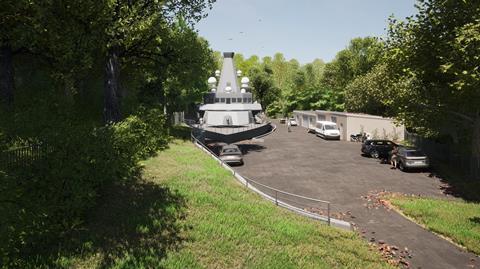An unusual architectural commission reminds us of the power of incongruity in the English landscape, writes Joe Holyoak

As a student, I was very taken with Hans Hollein’s 1964 photomontage of an aircraft carrier poised menacingly on a hilltop in an empty rolling landscape. It has the attention-grabbing incongruity of a fish riding a bicycle, combined with the heroic quality of an architectural monument dominating the landscape, imagery which was so prevalent in the culture at that time.
It is perhaps an eccentric and too-literal derivation from Le Corbusier’s identification of the modern ship – specifically the ocean liner – as a paradigm of functional design for architects to emulate, which he presented in Vers une Architecture in 1923. The photograph on the cover was not of one of his buildings, but of the promenade deck of the Cunard ship Aquitania.
Le Corbusier’s aspirations for a functionalist architecture proved to be misguided and unachievable. Although, at a superficial level, the comparison between buildings and ships has yielded much in the way of nautical style.
One thinks for example of James Stirling’s tubular balustrades at the Cambridge History Faculty, and the rows of portholes in his Southgate housing in Runcorn. But outside of an infants’ playground, it is unusual to find a building made expressly in the shape of a ship. The two inhabit quite separate parts of the world, after all.

Having started this column on the plane of High Architecture, I am now going to descend to the plane of architectural kitsch. But it is kitsch with a serious purpose, and with an important point to make.
In Sutton Coldfield, about as far from the sea as you can get in the UK, there is a building in the form of a warship. It was self-built in 1952 by the Sutton Coldfield Sea Cadets on a site on the edge of Sutton Park, as their headquarters, and it has served that purpose ever since.
It was modelled on the World War I minesweeper HMS Sutton, and was built in concrete blockwork, with the main superstructure using components of a WWII Anderson bomb shelter. It is clearly appropriate to have a pretend ship in this situation, enabling young cadets to have the spatial experience of doing maritime exercises on board, without having to travel.
It is now in pretty poor repair, having probably lasted longer than anyone anticipated in 1952. Now there is a proposal to demolish it, and replace it with a new, more modern ship, designed by the local firm Collaborative Architecture (CoARC). Birmingham City Council referred the planning application to the 20th Century Society, as it deemed the 1952 ship to be a non-designated heritage asset.
The Society’s Casework Committee decided to apply for Training Ship Sutton Coldfield to be statutorily listed. This was not on the basis of its architectural quality, which is minimal, but on the basis of its uniqueness and its historical interest. Historic England was not sufficiently impressed, and the application was turned down.
This was perhaps inevitable, as the significance of the ship is partly, if not largely, as a piece of intangible heritage. It was a cheaply-made self-built enterprise, paid for by fundraising activities by the sea cadets themselves.
It is a record of youthful initiative, part of an ongoing history of military activity in Sutton Coldfield, in Sutton Park particularly, which arguably began with the Romans (a Roman road runs through the park). The initiative continues, and is renewing itself with a new structure to replace the old one.

The new ship will be bigger, on the same site as the present ship. It is modelled on a Type 26 Global Combat Ship, several of which are currently being built at the Govan and Scotstoun Yard on the Clyde.
Although CoARC are commissioned by the Sea Cadets, for security reasons the Navy will not give them details of the ship. Instead CoARC are relying on a computer model made by an amateur warship enthusiast.
They are scaling down the construction to about 2/3 of the actual size, and making modifications in order to accommodate the spaces the cadets require: 100 cadets will be able to sleep on the ship.
The hull will be built of concrete, and the superstructure will be riveted steel cladding on a steel frame, looking as close to genuine warship construction as they can make it. The angled geometry will be complicated to make.
My view is that the incongruity should be welcomed
It will have a tall radar tower, and the conventional concern of a planning officer would be that it could be seen above the trees from Sutton Park, which is both a Registered Park and a Scheduled Monument. It will be an incongruous addition to the landscape.
My view is that the incongruity should be welcomed, and that the new ship should be made more visible than its predecessor, not less. The English have a distinct liking for incongruity.
Also, because seeing a warship in the middle of England is so unexpected – apparently there are no other buildings like it in the UK – there should be a programme of interpretation, to explain to passers-by the history of both the old ship, which will have disappeared, and the new one which will have taken its place.
It is a challenge to conservationists to accept the replacement of a heritage asset, but I think this is probably the correct decision. The new ship is not going to have the violent impact of Hollein’s aircraft carrier, but it will add a bit of drama to a quiet corner of Sutton Coldfield, and it will continue an intriguing narrative in which architecture plays a part.
>> Also read: Practice floats plans for £3m ‘warship’ base for Sea Cadets
Postscript
Joe Holyoak is an architect and urban designer practising in Birmingham


















2 Readers' comments